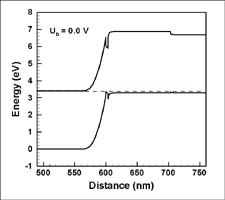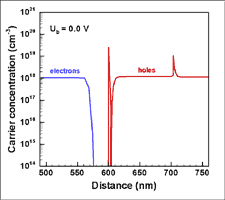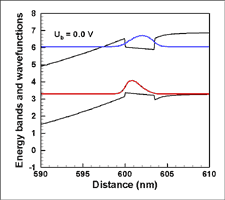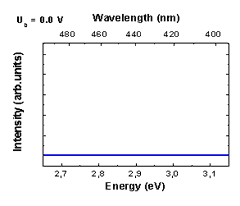Simulator for Light Emitters based on Nitride Semiconductors (SiLENSe)—software tool for light emitting
diode bandgap engineering.
1. Overview
Soft-Impact develops physical and chemical models for
several software products designed by
STR, Inc.
Soft-Impact provided physical models for the software tool
SiLENSe
developed in STR for modeling band diagrams and characteristics of
light emitting diodes (LEDs) based on group-III nitrides.
These models allow the SiLENSe software to provide researchers
with exhaustive information about complex
physical processes responsible for the operation of group-III
nitride-based LEDs.
The code provides the following properties of an LED heterostructure:
- Band diagram of a nitride LED at various biases
- Distribution of electron and hole concentrations in the device structure
- Electric field distribution
- Radiative and non-radiative recombination rates
- Current-voltage (I-V) characteristic
- Internal light emission efficiency as a function of current density
- Wave functions of electrons and holes in a quantum-well active region
- Light emission spectra of the LED
The above information forms a good basis for the LED structure optimization and for development of new
light emitting devices.
2. Examples of simulations
Shown below are some results of simulations of a simple blue SQW LED structure consisting of n-GaN contact layer
(Nd = 3E18 cm-3), an undoped 20%-InGaN SQW active region 3.5 nm thick, a p-type 10%-AlGaN emitter (Na = 7E19 cm-3),
and a p-GaN contact layer (Na = 7E19 cm-3).
3. Underlying physics
The LED operation is considered within the 1D drift-diffusion model of carrier transport in the heterostructure
that accounts for specific features of the nitride semiconductors - strong piezoeffect, existence of spontaneous
electric polarization, low efficiency of acceptor activation, and high threading dislocation density
(normally, ~1e7-1e9 cm-2) in the material. Additionally, the code is capable of modeling graded-composition
heterostructures, which is important in view of the use of bandgap engineering principles. Along with bimolecular
radiative electron and hole recombination, an original model of non-radiative carrier recombination on threading
dislocation cores is incorporated into the SiLENSe code. The latter allows analyzing the interplay between the
radiative and non-radiative recombination channels and predicting the internal emission efficiency of the LED
structure as a function of threading dislocation density. The spectrum of light emission from a single- or
multiple-quantum-well active region can be calculated with account of the complex valence band structure of
nitride semiconductors by using the 8x8 Kane Hamiltonian. For this, a self-consistent solution of the Poisson
and Schrodinger equations is found within the effective-mass approximation. Procedure of the quantum-well region
identification and respective grid generation is totally automatized in the SiLENSe code. The SiLENSe code is
supplied by a database of materials properties necessary for simulations.
The model implemented into the SiLENSe code used the following assumptions:
- exact account of localized and distributed polarization charges in the LED structure induced by both
spontaneous and piezo polarization in nitride semiconductors;
- the Fermi statistics is used for electrons and holes covering the cases of both degenerate
and non-degenerate semiconductors;
- partial ionization of donors and acceptors depending on the respective quasi-Fermi level
positions is allowed for;
- strain in the LED structure is calculated assuming coherent growth of all epilayers on
an underlying buffer layer;
- bimolecular radiative electron and hole recombination is considered with neglect
of quantum-confined effects on the recombination rate;
- non-radiative carrier recombination considers the principal channel, recombination on threading
dislocation cores;
- I-V characteristic of an LED is computed with a given serial resistance that should account
for both the lateral current spreading in the LED chip and ohmic contact resistances;
- light emission spectra are computed with a post-processing module operating with the band profiles
of the LED structure obtained and accounting for (i) the complex structure of the valence band of nitride
materials and (ii) the contribution of the confined electronic states.




